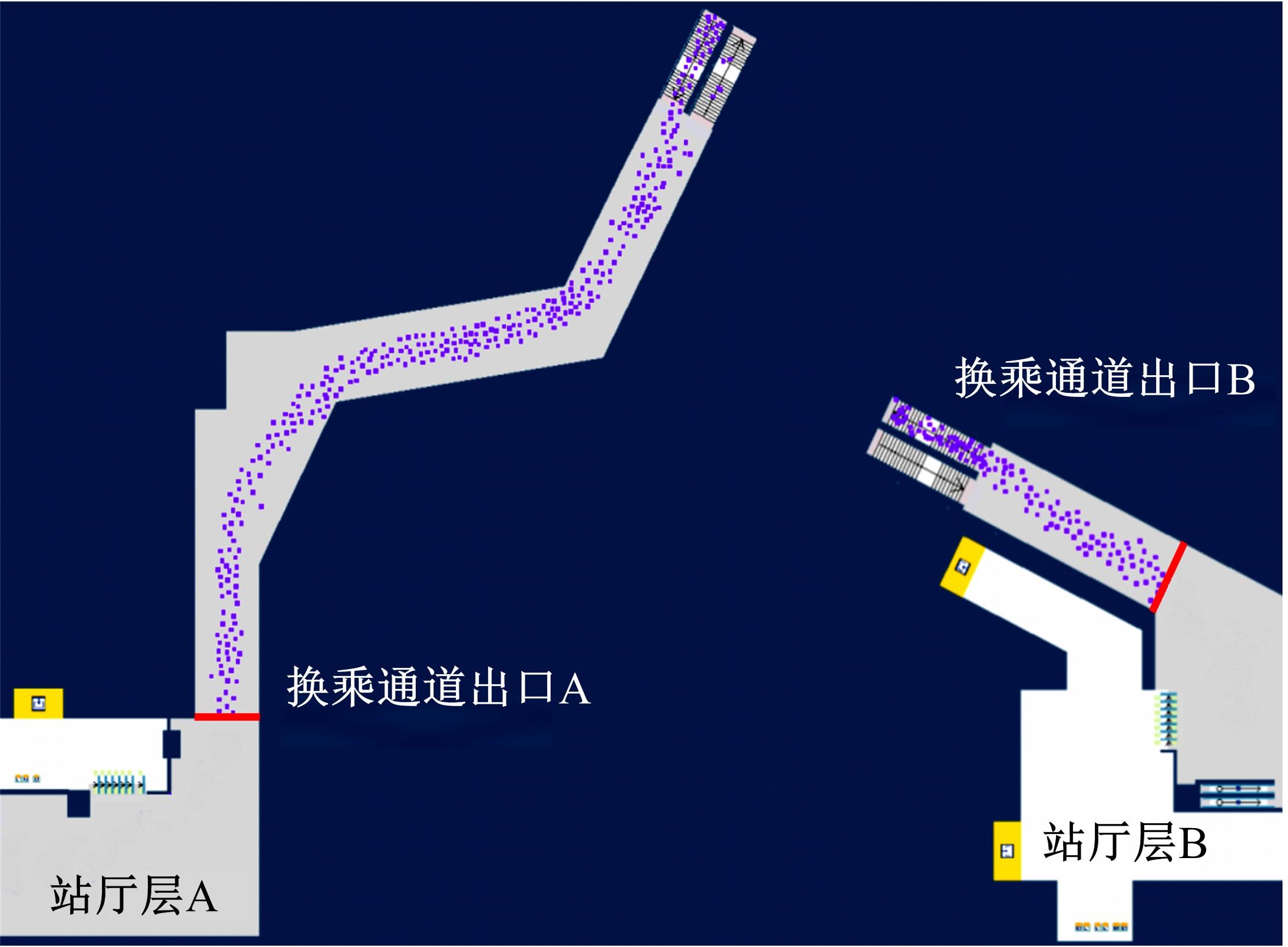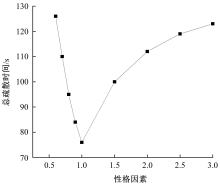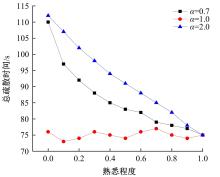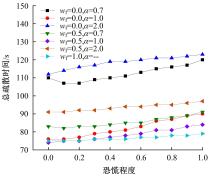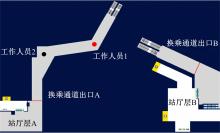Journal of Jilin University(Engineering and Technology Edition) ›› 2022, Vol. 52 ›› Issue (11): 2600-2606.doi: 10.13229/j.cnki.jdxbgxb20200946
Simulation modeling of pedestrian target decision⁃making in evacuation process in transfer corridors of subway stations
Jie MA1,2( ),Jia-jun HUANG3,Jun TIAN4,Yang-hui DONG2
),Jia-jun HUANG3,Jun TIAN4,Yang-hui DONG2
- 1.School of Traffic and Transportation,Beijing Jiaotong University,Beijing 100044,China
2.Beijing Transport Institute,Beijing 100073,China
3.College of Transportation Engineering,Tongji University,Shanghai 201804,China
4.School of Environment and Civil Engineering,Dongguan University of Technology,Dongguan 523808,China
CLC Number:
- U291.69
| 1 | Kirchner A, Schadschneider A. Simulation of evacuation processes using a bionics-inspired cellular automaton model for pedestrian dynamics[J]. Physica A: Satistical Mechanics and its Applications, 2002, 312(1/2): 260-276. |
| 2 | Varas A, Cornejo M D, Mainemer D, et al. Cellular automaton model for evacuation process with obstacles[J]. Physica A: Statistical Mechanics and its Applications, 2007, 382(2): 631-642. |
| 3 | Yang L Z, Zhao D L, Li J, et al. Simulation of the kin behavior in building occupant evacuation based on cellular automaton[J]. Building and Environment, 2005, 40(3): 411-415. |
| 4 | Gao J, Zhang J, He J, et al. Experiment and simulation of pedestrian's behaviors during evacuation in an office[J]. Physica A: Statistical Mechanics and its Applications, 2020, 545: 123749. |
| 5 | Helbing D, Illés F, Tamás V. Simulating dynamical features of escape panic[J]. Nature, 2000, 407(6803): 487-490. |
| 6 | 张大伟, 祝海涛. 考虑行人差异性的人群疏散最优决策理论模型[J]. 吉林大学学报: 工学版, 2020, 50(2):549-556. |
| Zhang Da-wei, Zhu Hai-tao. An optimization-based evacuation model considering pedestrian heterogeneity [J]. Journal of Jilin University(Engineering and Technology Edition), 2020, 50(2):549-556. | |
| 7 | 马洁, 徐瑞华, 黄家骏. 基于危险源影响的地铁车站乘客疏散仿真模型[J]. 系统工程理论与实践, 2016, 36(6): 1585-1592. |
| Ma Jie, Xu Rui-hua, Huang Jia-jun. Simulation of pedestrian evacuation processes in a metro station considering the effect of dangerous source[J]. Systems Engineering-Theory & Practice, 2016, 36(6): 1585-1592. | |
| 8 | Heliövaara S, Kuusinen J M, Rinne T, et al. Pedestrian behavior and exit selection in evacuation of a corridor—An experimental study[J]. Safety Science, 2012, 50(2): 221-227. |
| 9 | Haghani M, Sarvi M, Shahhoseini Z. Evacuation behaviour of crowds under high and low levels of urgency: experiments of reaction time, exit choice and exit-choice adaptation[J]. Safety Science, 2020, 126: 104679. |
| 10 | Fu L, Fang J, Cao S, et al. A cellular automaton model for exit selection behavior simulation during evacuation processes[J]. Procedia Engineering, 2018, 211: 169-175. |
| 11 | Huang H J, Guo R Y. Static floor field and exit choice for pedestrian evacuation in rooms with internal obstacles and multiple exits[J]. Physical Review E, 2008, 78(2): 021131. |
| 12 | Haghani M, Sarvi M. Human exit choice in crowded built environments: investigating underlying behavioural differences between normal egress and emergency evacuations[J]. Fire Safety Journal, 2016, 85: 1-9. |
| 13 | Haghani M, Sarvi M. Simulating dynamics of adaptive exit-choice changing in crowd evacuations: model implementation and behavioural interpretations[J]. Transportation Research Part C: Emerging Technologies, 2019, 103: 56-82. |
| 14 | 高鹏. 基于多智能体的轨道交通车站客流仿真模型及理论研究[D]. 上海: 同济大学交通运输工程学院, 2010. |
| Gao Peng. Agent-based simulation model for passengers in urban mass transit station[D]. Shanghai: College of Transportation Engineering, Tongji University, 2010. | |
| 15 | 张玉明. 环境行为与人体工程学[M]. 北京: 中国电力出版社, 2011. |
| [1] | Song FANG,Jian-xiao MA,Gen LI,Ling-hong SHEN,Chu-bo XU. Traffic risk analysis of moving work zone on right lane of city expressway [J]. Journal of Jilin University(Engineering and Technology Edition), 2022, 52(8): 1786-1791. |
| [2] | Song-xue GAI,Xiao-qing ZENG,Xiao-yuan YUE,Zi-hao YUAN. Parking guidance model based on user and system bi⁃level optimization algorithm [J]. Journal of Jilin University(Engineering and Technology Edition), 2022, 52(6): 1344-1352. |
| [3] | Hong-feng XU,Hong-jin CHEN,Dong ZHANG,Qian-hui LU,Na AN,Xian-cai Geng. Fully⁃actuated signal timing technique for isolated signalized intersections in connected vehicle environment [J]. Journal of Jilin University(Engineering and Technology Edition), 2022, 52(6): 1324-1336. |
| [4] | Heng-yan PAN,Wen-hui ZHANG,Bao-yu HU,Zun-yan LIU,Yong-gang WANG,Xiao ZHANG. Construction and robustness analysis of urban weighted subway⁃bus composite network [J]. Journal of Jilin University(Engineering and Technology Edition), 2022, 52(11): 2582-2591. |
| [5] | Jing-xian WU,Hua-peng SHEN,Yin HAN,Min YANG. Residents' commuting time model under the nonlinear impact of urban built environment [J]. Journal of Jilin University(Engineering and Technology Edition), 2022, 52(11): 2568-2573. |
| [6] | Feng XUE,Chuan-lei HE,Qian HUANG,Jian LUO. Coordination degree of multimodal rail transit network [J]. Journal of Jilin University(Engineering and Technology Edition), 2021, 51(6): 2040-2050. |
| [7] | Bo PENG,Yuan-yuan ZHANG,Yu-ting WANG,Ju TANG,Ji-ming XIE. Automatic traffic state recognition from videos based on auto⁃encoder and classifiers [J]. Journal of Jilin University(Engineering and Technology Edition), 2021, 51(3): 886-892. |
| [8] | Dian-hai WANG,Xin-yi SHEN,Xiao-qin LUO,Sheng JIN. Offset optimization with minimum average vehicle delay [J]. Journal of Jilin University(Engineering and Technology Edition), 2021, 51(2): 511-523. |
| [9] | Xian-min SONG,Ming-ye ZHANG,Zhen-jian LI,Xin WANG,Ya-nan ZHANG. Setting of dynamic bus lane and its simulation analysis and evaluation [J]. Journal of Jilin University(Engineering and Technology Edition), 2020, 50(5): 1677-1686. |
| [10] | Hong-fei JIA,Xin-ru DING,Li-li YANG. Bi-level programming model for optimization design of tidal lane [J]. Journal of Jilin University(Engineering and Technology Edition), 2020, 50(2): 535-542. |
| [11] | Chao-ying YIN,Chun-fu SHAO,Xiao-quan WANG,Zhi-hua XIONG. Influence of built environment on commuting mode choice considering spatial heterogeneity [J]. Journal of Jilin University(Engineering and Technology Edition), 2020, 50(2): 543-548. |
| [12] | Da-wei ZHANG,Hai-tao ZHU. An optimization⁃based evacuation model considering pedestrian heterogeneity [J]. Journal of Jilin University(Engineering and Technology Edition), 2020, 50(2): 549-556. |
| [13] | Yuan-li GU, Yuan ZHANG, Xiao-ping RUI, Wen-qi LU, Meng LI, Shuo WANG. Short⁃term traffic flow prediction based on LSSVMoptimized by immune algorithm [J]. Journal of Jilin University(Engineering and Technology Edition), 2019, 49(6): 1852-1857. |
| [14] | Yi-ming BIE,Kai JIANG,Ru-ru TANG,Lin-hong WANG,Xin-yu XIONG. Time of interval partition for traffic control at isolated intersection considering impacts of plan transition [J]. Journal of Jilin University(Engineering and Technology Edition), 2019, 49(6): 1844-1851. |
| [15] | Guo-zhu CHENG, Si-he FENG, Tian-jun FENG. Setting condition of on⁃street parking space occupied vehicle lane [J]. Journal of Jilin University(Engineering and Technology Edition), 2019, 49(6): 1858-1864. |
|
||

